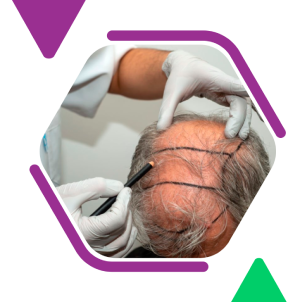Complications of Hair Transplant

Hair transplantation, although generally effective for restoring hair, is a complex surgical procedure with numerous potential complications of hair transplant. Each complication arises from a combination of biological, technical, and procedural factors. Understanding these complications of hair transplant involves exploring their origins, implications, and interrelationships.
- Infection
Infection is a significant concern in complications of hair transplant surgeries due to the invasive nature of the procedure. The scalp, after numerous incisions for graft insertion, becomes a potential site for bacterial, fungal, or viral pathogens. The risk of infection is heightened by factors such as sterilization protocols during surgery, the patient’s pre-existing health conditions, and post-operative care. Despite rigorous sterile techniques, infection risk exists due to scalp manipulation and small wounds. Pathogens may be introduced through contact or air if sterility is not maintained. Patients with compromised immune systems or pre-existing conditions like diabetes are at higher risk. Effective management involves stringent surgical sterilization, patient education on post-operative care, and prompt antibiotic intervention if symptoms arise.
- Bleeding
Bleeding is another critical concern in complications of hair transplant, arising from the disruption of blood vessels during the grafting process. While minor bleeding is normal, excessive bleeding can complicate the surgery and affect the outcome. The precision of the surgeon plays a crucial role, and advanced techniques like follicular unit extraction (FUE) often result in less bleeding compared to older methods. Patients with conditions affecting blood clotting or those on blood-thinning medications are at higher risk. Addressing bleeding involves careful surgical technique, the use of hemostatic agents, and monitoring blood pressure and clotting status. In severe cases, additional interventions may be needed.
- Swelling
Swelling, or edema, is a common response to surgical trauma and a notable complication of hair transplant. The body’s inflammatory response leads to fluid accumulation in tissues, causing puffiness around the forehead and eyes. The extent of swelling is influenced by the surgical trauma and individual healing responses. Management focuses on reducing inflammation through cold compresses, keeping the head elevated, and using anti-inflammatory medications. Swelling typically subsides within a week as healing progresses.
- Pain
Pain is a multifaceted issue in complications of hair transplant surgeries, influenced by physiological and psychological responses. Pain levels vary depending on the surgical approach and individual sensitivity. The manipulation of tissues and graft insertion cause pain through nociceptor activation. Inflammation resulting from the surgery can exacerbate pain, and the healing process itself can be uncomfortable. Pain management involves pre-operative and post-operative analgesics, balancing effective relief with minimizing side effects.
- Scarring
Scarring is a visible complication of hair transplant resulting from the body’s healing process after injury. The extent of scarring is influenced by surgical technique and genetic predisposition. Minimizing damage to surrounding tissues and using advanced techniques like FUE can reduce scarring. Some individuals are genetically predisposed to noticeable scars, such as keloids. Management includes techniques to minimize scar formation and treatments like laser therapy or silicone gel applications if scars are prominent.
- Shock Loss
Shock loss refers to the temporary loss of hair in the area surrounding transplanted grafts, a reaction to the trauma of the transplant procedure. The trauma can induce a stress response in existing hair follicles, causing them to shed prematurely. The disruption of the hair growth cycle leads to the shedding of hairs in the growth phase. Shock loss is usually temporary, with hair typically regrowing as follicles recover. Monitoring and supportive care are essential to manage expectations and ensure normal hair growth cycle resumption.
- Graft Failure
Graft failure occurs when transplanted hair follicles do not establish themselves successfully in the recipient area, resulting in incomplete or uneven hair coverage. Factors contributing to graft failure include poor handling, excessive drying, or mechanical trauma. The health and condition of the recipient site, including blood supply and tissue quality, are crucial for graft survival. Improving graft survival involves meticulous handling, optimal placement techniques, and ensuring proper recipient site preparation. Follow-up care is critical for transplanted follicles to adapt and grow.
- Uneven Hair Growth
Uneven hair growth occurs when transplanted follicles grow at different rates or in inconsistent patterns, leading to an uneven appearance. Differences in follicle survival and growth rates can contribute to this issue. Addressing uneven growth may require additional interventions, such as touch-up procedures or extra transplant sessions, to achieve a more uniform appearance.
- Itching and Discomfort
Itching and discomfort during recovery are minor complications of hair transplant. These symptoms are a natural part of the healing process but can be bothersome. The inflammatory response and formation of scabs can contribute to itching and discomfort. Management involves using prescribed topical treatments, avoiding scratching, and following aftercare instructions to minimize irritation and promote healing.
- Cyst Formation
Cysts can form in the scalp due to blocked hair follicles or sebaceous glands, adding to the list of complications of hair transplant. These benign cysts can cause discomfort or cosmetic concerns. Cysts result from follicular blockage or post-surgical changes disrupting normal follicular function. Management typically involves monitoring cysts and, if necessary, performing minor surgical procedures to remove or drain them.
- Poor Hair Growth
Poor hair growth is characterized by insufficient hair density or quality in the transplanted area. Factors affecting follicle survival and function contribute to this issue. Successful hair growth depends on the ability of transplanted follicles to adapt and thrive in the recipient area. To address poor hair growth, further evaluation of the transplant technique and potential additional treatments or procedures may be necessary.
- Asymmetry
Asymmetry in hair transplant results occurs when transplanted hair does not grow evenly, leading to an uneven appearance in the hairline or overall coverage. Placement accuracy and individual follicle growth patterns contribute to asymmetry. Corrective measures often involve additional procedures to refine the hairline and achieve a more balanced appearance.
- Allergic Reactions
Allergic reactions to medications or materials used during or after the hair transplant can complicate recovery. These reactions arise from the body’s immune response to allergens. Some individuals may have sensitivities or allergies to medications, anesthesia, or topical treatments. Management involves identifying potential allergens, adjusting medications or treatments, and providing supportive care to mitigate reactions.
- Numbness
Numbness in the scalp can occur due to nerve damage or irritation during the hair transplant procedure. It can be temporary or, in rare cases, persistent. Nerve trauma from surgical manipulation can lead to reduced sensation or numbness. The extent of numbness depends on the nerve’s ability to heal and regenerate. Numbness is typically managed by monitoring recovery and providing supportive care, with sensation usually returning as nerves recover.
Our Services
- Hair Loss
- Causes of Hair Loss
- Clinical Features
- Laboratory Test
- Medical Treatment
- Cyclic Treatment
- PRP
- Hair Transplant
- Surgical Treatment
- FUE
- FUT
- Beard Reconstruction
- Moustache Reconstruction
- Eyebrow Reconstruction
- Side Burn Reconstruction
- Complications of Hair Transplant
- Alopecia Areata
- Telogen Effluvium
- Laser Treatment



 Book an Appointment
Book an Appointment